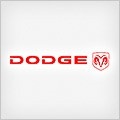
DODGE Charger
Generations Timeline, Specs and Pictures

The 2015 Charger was not a car that could blend in the crowd, but it was a car that could be a smooth family sedan or a pursuit Police cruiser.
The Charger name was brought back in 2005 and its retro-design look was very appreciated by the customers, who didn’t care if the original Charger was a 2-door sedan and the new model was a 4-door vehicle. It was the sixth generation of an almost forgotten name in the Dodge stable. In 2011 the model was changed and, in 2014, it received a major facelift.
For the exterior, the 2015 model received more rounded headlights and in the lower part of the apron, the designers installed LED daytime running lights. The front grille was different, depending on the engine. To suit all the needs, the customers could choose between 14 different alloy wheels.
Inside, the makeover brought a new instrument cluster with a 7” TFT display for the on-board computer. The infotainment Uconnect system was available with up to an 8.4” touch-screen on the center stack. The sport-bucket seats were available for most of the engine range.
The 2015 Charger was available with rear or all-wheel-drive, depending on the engine. The base unit was a 3.6-liter V6, while the top of the range was the SRT Hellcat that boosted out 707 hp. The latter was available with RWD only. The only transmission available for the entire range was an 8-speed automatic.
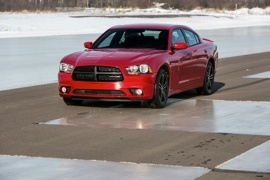
The second-generation Dodge Charger (LX) underwent a series of exterior changes, with the most important updates being applied to the front fascia and the rear end, translating into a redesigned grille and hood and the introduction of the brand’s “racetrack” taillights.
Inside, the four-door fastback coupe, as it was dubbed by Dodge, gained premium soft-touch materials, Uconnect Touch, Garmin navigation and a number of other convenience features. Offered in SE, R/T and R/T AWD versions, the Charger became available with Chrysler’s Pentastar V6 and the iconic 5.7-liter Hemi V8, which deliveres 370 horsepower.

Daimler Chrysler revived the old glorious Charger name from the nameplates shelf and brought it back to daylight in 2005 when Dodge unleashed the four-door sedan.
While the previous genuine Charger was a true muscle-car, the 2005 model was a four-door sedan based on the same platform as the Chrysler 300 Sedan and the Dodge Magnum station wagon. Dodge built it for those who were teenagers in the late ’60s and early ’70s, and now they needed a family sedan.
Just by looking at the Charger, it was somehow surprising that it featured four doors. Its coupe-like stance with narrow and pinched windows line gave the impression of a four-door coupe, in the American way. Its double, round headlights and the cross-hair grille left no doubts about the car’s brand even without a badge on it. The wrapped-around plastic bumper sported two fog lights at the bottom and a wide lower grille in the apron. From its sides, the rear fenders’ raised shoulders started from the back of the rear doors while the sloped rear windscreen mimicked a coupe-like silhouette.
Inside, depending on the engine option, the Charger featured bucket seats or high-bolstered seats. Its instrument cluster raised from the dash panel under a sweeping line and sported four dials and two LCDs at the bottom of the speedometer and tachometer. On the center stack, Dodge installed as an option an infotainment unit with navigation, CD, and Bluetooth connectivity. In the back, due to the high transmission tunnel, the bench was good only for two occupants but not too tall. The greenhouse was not that tall.
Dodge installed a few engine choices under the hood, ranging from a 2.7-liter up to the mean SRT8 version powered by a 5.70-liter V-8 engine. Power went to the rear wheels only.
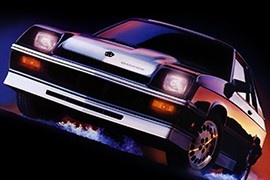
Only the name resembled the former glorious muscle car when Dodge introduced the 1981 Charger on the market.
Dodge introduced the 1982 Charger in the summer of ‘81, and it was the first with a front-engine and front-wheel-drive system. Unlike its predecessors, which offered big V-8s under the hood, this one was just a four-banger aiming at the European sport-compact coupes such as the Renault 17 or the Volkswagen Scirocco. But the big carmaker was in deep financial troubles, and it needed a car to sell in high volumes, and the former gas-guzzlers just couldn’t do that, especially with another oil crisis in the public memory.
It looked was a hatchback designed on the newer standards with a wedged-shape bodywork. At the front, it featured rectangular headlights in individual clusters and a narrow grille between them, between the hood and the bumper. A wrapped-around plastic bumper that respected the 5-mph rule was added to the car, and its apron was aerodynamically studied to increase the downforce onto the front wheels. But building a hatchback was not one of the American’s carmaker specialties, and that was obvious on the C-pillar, which was very thick.
Inside, Dodge installed bucket seats with high bolstered areas to keep their occupants in place. Unfortunately, the car’s platform didn’t do a job as well as the seats. The carmaker installed a folding rear bench in the back, thus increasing the otherwise limited trunk room.
Under the hood, the Charger started with a 2.2-liter engine which couldn’t provide 100 hp. Its performances were barely in the same league with a Volkswagen Golf GTI. Its five-speed manual was geared for quick acceleration but with longer, higher gears for fuel-efficiency. Thus, the 1981 Charger proved to be a sporty-looking commuter vehicle, but not a sports car.
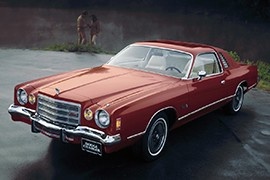
Introduced in 1974 as a 1975 model year, the fourth generation Dodge Charger moved from the musclecar ideology to the luxury grand touring coupe.
It shared its body with the Chrysler Cordoba, both being based on the B platform. The imposing full-width grille was now gone, being replaced by a smaller rectangular and more regular one placed in the middle and guarded by round headlights. The side profile got toned down and so was the rear, with vertical lamps and a big trunk. As with previous generations, the 1975 Charger was offered with a variety of engines and in different trim levels like base, Sport, SE, and Daytona.

Dodge said the last farewell to the muscle-car era with the third generation of the Charger in 1971, before the CAFE rules and the insurance policies killed the movement.
With a name already respected on the streets, the third generation of the Charger tried to make a comeback with better marks in the handling department and better quarter-mile times. But Chrysler tried more and enriched the equipment list adding headlights washers, stabilizer bars both front and rear, and a more refined interior.
From the outside, the Charger featured a shorter wheelbase and overall length. Also, the carmaker made the coupe wider and with increased tracks both front and rear. The grille lost the nameplate from the left headlight cover, and the front doors lost their sculptured fake vents from the front area. A major difference was on the B-pillar, which was thicker. Thus, the car lost its fake-cabriolet shape since the rear side windows were smaller.
Inside, the Charger still could accommodate up to five people, with better headroom for the rear seat passengers, but the carmaker profiled the bench to be comfortable just for two adults. At the front, the instrument cluster raised from the dashboard line, covering the dials and the gauges. Between the front seats, the carmaker mounted a floor shifter for both versions, automatic or manual.
Under the hood, Chrysler installed a wide choice of engines that ranged from a small, inline-six unit that provided just 110 hp and went all the way to a 7.0-liter V-8 which put down 425 hp for the most powerful version.

Dodge built the 1969 Charger 500 to get the homologation and race in NASCAR, but it couldn’t win the championship despite all the efforts.
By the late ‘60, the carmakers understood that aerodynamics plays a crucial role in motorsport, and they tried to adapt as soon as possible. Chrysler worked with Lockheed-Martin and studied the Dodge Charger in their aerodynamic tunnel. The standard vehicle was a disaster, and modifications followed. The first result was the Charger 500, which was supposed to dominate the NASCAR championship but lost it to Ford. Chrysler had to build at least 500 vehicles, but somewhere on the way, it lost the count and stopped at less than 400 units.
At the front, the car sported the same four round headlights and a thinner metallic bumper. Its grille was flush to the hood’s leading edge. It was supposed to have an apron too, but Bill France (then the head of NASCAR) was reluctant in aerodynamic features and didn’t approve it. On the A-pillars, the engineers added chromed elements that made the air ran smoother to the sides. The most significant modification was at the rear, where the taillights were installed into a cavity that formed huge swirls over the trunk. Instead of redesigning the entire rear panel, the carmaker added a clear panel over the taillights, and that fixed the problem.
The interior was mostly a stock Charger with some unique badges. Its vinyl-covered bucket seats sported adjustable headrests, but those counted only for the street vehicles. On the manual gearbox versions, the carmaker installed an angled gear-stick toward the driver.
Under the hood, Dodge installed a choice of two engines: a 426 Hemi and, after some debates, a 440, respectively. Chrysler offered the car with the latter to help it sell more units.
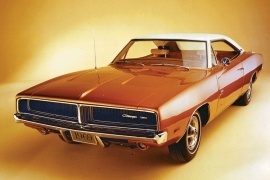
First introduced in the early 60s, the Charger was Dodge’s choice of a fastback look with the already existing technology.
The iconic 1968 model was completely different from the previous version, starting with the exterior design that was redesigned: the front end featured a flat black grille, round marker lights were present on the sides and at the rear end, the Charger had round taillights.
The second generation was produced between 1968 and 1970, the 70s model featuring slight updates.
The Charger was featured in the Bullitt movie and that helped the brand to gain even more fans for the notable car chase with the Ford Mustang GT through the streets of San Francisco.
Notable updates were made in the Charger’s cabin as well, such as the removal of the central armrest, the rear bucket seats were replaced by fixed rear seats, conventional gauges were added and the trunk was equipped with a vinyl mat.
Getting to the most interesting part, the 1968 Charger ran on a standard 5.2-liter V8 engine and the high performance package offered a 375 hp or a 425 hp HEMI engine. Talking about the R/T package, it was easily recognisable for its bumblebee stripes.
While the HEMI engine was available only with the R/T Package, the Magnum was a great choice of a powerful powerplant that was more street-friendly.
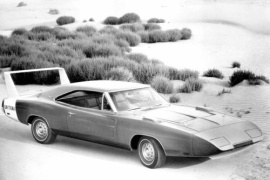
Chrysler was losing ground in front of Ford on the NASCAR racetrack and ordered its engineers to do something about it, and the answer was the Charger Daytona.
While the Charger was a respected name in the muscle-car arena, its name was unknown in the victory circle. The engineers returned to their drawing boards and came up with the Daytona version. It was unique on the market, and it led to NASCAR regulation changes.
The Daytona version was easy to spot due to its 2’ (610 mm) high rear wing on the trunk, which attracted more views than the steel cone from the front. Unlike the regular Charger, the Daytona version featured pop-up headlights. Chrysler’s engineers came with an aerodynamic package solution to prevent the big brick from lifting from the ground at higher speeds. Chrysler tested the car in the Lockheed-Martin wind tunnel, and it showed a 20% improvement in its aerodynamic. It proved that at Talladega raceway were Buddy Baker reached 200.447 mph (322.58 kph). It was the first NASCAR race-car to exceed the 200 mph barrier.
Inside, all Charger Daytonas featured a wood panel as the dashboard, with two large dials in front of the driver and another four gauges on its right side. Its standard front bucket seats didn’t feature a high bolstering for the street versions since they were changed anyway for track use.
Dodge installed a choice of two engines under the Daytona’s hood: the standard 7.2-liter Magnum V-8 with an option for the 7.0-liter Hemi engine, which was much more powerful. Since the car was based on the Charger R/T version, it featured a heavy-duty suspension and brake system.

The Dodge Charger was a model introduced by Dodge in 1965.
The 1966 to 1974 Chargers were sporty models based on the Chrysler B platform that could be ordered with high-performance options. The car still resembled a Coronet or the AMC Rambler Marlin concept and was rather a luxury fastback model than a top-tier muscle car during the first generation. The interior came with semi-bucket back seats that could be folded down to increase luggage space along with a wood-grain steering wheel, front bucket seats, a full-length console, and an interesting dashboard for the period which was using electroluminescence to light up at night.























































